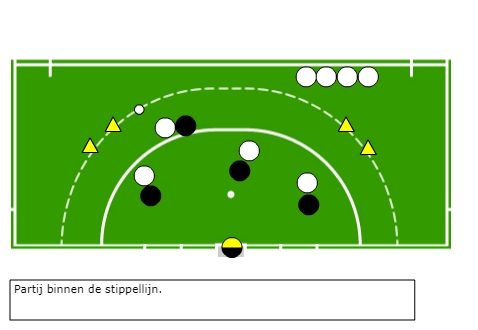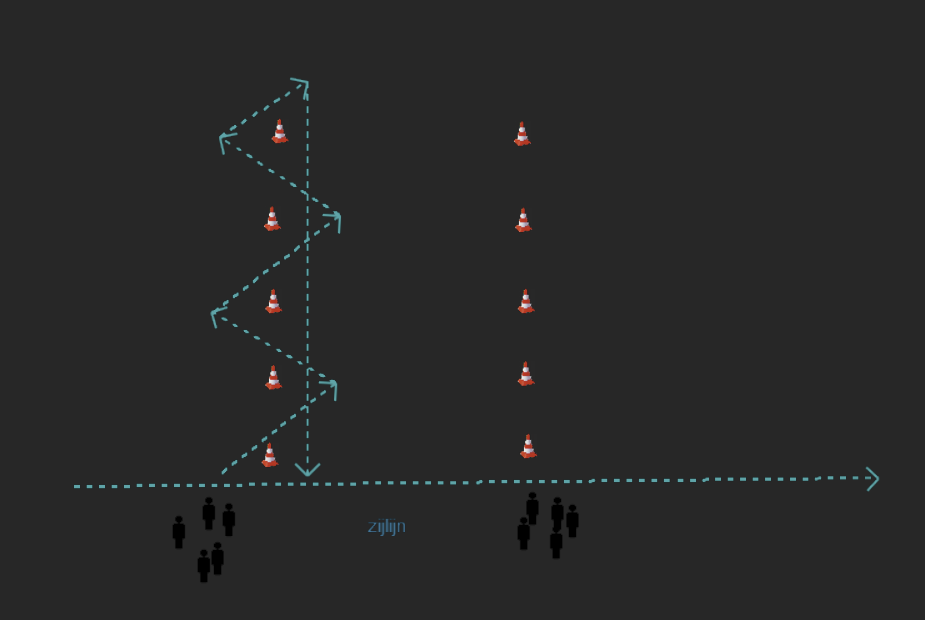Hockey drills
- 2 pawns face each other,
- at a random distance (depends on whether you want to push or flatten, for example).
- Player 1 and 3 stand with pawn A.
- Player 2 stands at pawn B.
- 1 plays the ball to player 2,
- 2 receives the ball.
- After player 1 passes the ball, he runs after his ball towards pion B.
- When player 2 has passed again he runs in the direction of pion A.
- etc. etcde
- You can play this exercise with minimum 3 players, maximum 5 otherwise the intensity will be very low.
Overplaying to score
- Two players continuously play the ball over
- until one of them is so close to the goal
- that he can score in the goal.
Variation 2-1 situation:
- Under pressure from the defender, the attackers must now play together and try to score.
- The defender can score a point by conquering the ball and then dribbling over the dead ball line.
- This is the short side without a goal.
Goal
:As an attack is to get the most out of your attackAs a
defense is to defend smartly.
Set-up:
- The field is up to the dotted line.
- The attackers take the ball from somewhere on the dotted line and must try to score.
- The defenders must try to defend the ball from the outside.
- The attackers score 3 points when they score; 2 points when they force a corner and 1 point when they have a good scoring chance.
- The defenders get 3 points when they defend the ball by playing in between the pawns; 2 points when they get a free hit and 1 point when they manage to play the ball over the touchline.
NB When defenders score, the ball does not have to be run between the pawns or accepted behind the pawns.

Variations:
- Adjust the size of those teams according to the amount of players available. You can also have one team on the sidelines and play a 2 to 3 minute game each time. That way there is a break and the players have time to discuss and analyse.
- The scoring pawns for the defenders can also be made smaller.
- You can play with a 'chameleon' and thus give the attackers an overtal when scoring is not going well.
Points of attention:
- Make sure it is clear who is picking up which man.
- As defenders, try to keep a low profile and prevent fouls.
- As the attackers, try to actively look for a foot.
- Look for opportunities to double-team When you, as the defender, realise that your man is not being active enough in the attack, help your buddy defend and push the attacker into a corner
- As the attacker, look for the backhand of your opponent. A right-wing attack is therefore often easier to execute than the other way around
- divide the team by 2 and run it.
- Sit on top and blow the whistle on any fouls called
- so they get used to it.

- A slalom exercise
- watch how the hands are holding the stick
- where they have the ball
- And if they use the stick properly when they run through the exercise!
- If it goes well, you can make a game of it and see if they master this. The team that has been through all the exercises first has won.
- Two players stand behind each other. Around them 4 pawns in an angle: 3 next to them/2 behind them
- The ball is passed to the player in front.
- She runs around the pawn in front, turns left and plays the second player between the pawns.
- The second player rebounds between the cones.
- This repeats itself, then the first player finishes on goal.
- Players divided into two groups on one side of the field.
- Two rows of cones next to each other.
- Players pass the ball back and forth while walking past the cones.
- Variations
- Individuals keep ball high along a row of cones, both groups independent of each other.
- Passing the ball two by two
- Individually dribble two balls at the same time, slalom through the cones
- Pass the ball and dribble a second ball at the same time (player says yes).
- Three of you play over 2 balls to the other side.
Goal
- To practise running through the ball in motion (accepting in the run).
Set up
- 2 players stand in a line (e.g. sideline)
- and 1 player stands 10-20 metres away.
- The first player of the team runs a few metres and then passes the ball to the second player.
- and passes the ball to the person standing alone.
- He starts running roughly at the time of the pass.
- This way, he runs through the ball at the moment he takes over.
- The person who passed then moves to the 1-ling position
- The exercise can be made more difficult by lengthening the distance between passes In addition, a passing move can be made before the pass.
Purpose
- Practicing different techniques. (Also useful to observe how things are going during the 1st training).
Set up
- All players line up on the baseline (or another line) and do a certain
- and do a certain exercise until the 23m line (or another line).
- This can be only floating, or floating + at whistle a drag or lift, etc.
- Important is that it is not about the fastest, but the best!
- You can make it easier or more difficult by making a difference in the exercise.
Goal
- To regain that ball feeling and get back into the swing of things.
Set up
- The players form pairs
- and they stand opposite each other on a few meters (5 for example).
- Then they start pushing each other.
- At a certain moment, they take some more distance and start flattening.
Goal
- The goal of this exercise is to learn to look ahead when floating. In addition, you train your ability to react.
Set up
- The players line up on, for example, the back line.
- The trainer stands 10-15 metres away from the players.
- At an agreed signal, the players start drifting towards an imaginary line at your height.
- But in the meantime, they have to look in front of them, because you raise a certain number of fingers and the players have to say that number.
- To make this exercise more difficult, you can ask the players to make a passing move on an agreed signal, or you can make the distance bigger, or the players have to walk instead of saying the number, to a point which corresponds with the number.
Play a 2-1 and try to score in the goal.
If the defender captures the ball, he passes it to the next duo.
Alternate the defender.







